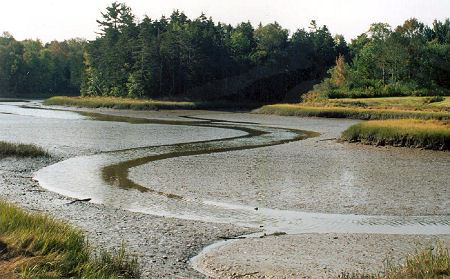![]()
On the road from Thomaston to Hathorn Point (1)
We have to realise, that a naturalistic painting as such is not a painting of a location, but the artist’s impression of the location or impression of his own feeling when he paints. In this way a location can be expressed in many different ways, dependent on the artist or the observer.
This was what I was thinking of when I in 2002, was driving from Thomaston to Hathorn Point to see the Olson House, and some of the other locations where Andrew Wyeth made his pictures. It could be argued that one should never look at locations and make comparisons with the paintings, but I think comparisons are interesting, because they tell how the artist uses the objects to express his feelings. In the case of an Andrew Wyeth painting, you will often see eliminations in the painting, eliminations that are felt, and therefore still present. It is often eliminations which give traces of people, of incidents, or earlier experience.
Wyeth talked about the importance of the objects in the landscape in an interview in Life. “I can’t work completely out of my imagination. I must put my foot in a bit of truth, and then I can fly free”, and also: “It is not the subject, it’s what you carry to it that’s important – what you feel about it, what you’ve dreamed about it”.
When you go south from Thomaston you pass Fales Store in Cushing on your right. Andrew Wyeth used to show his watercolours in this shop when he was young1. On the roof of Fales Store you will see a lightning rod, similar to the one shown in Northern Point on Henry Teel’s house on the island. The construction with a glass sphere is obviously a typical Maine design.

A lightning rod on Fales Store
The location for the painting Tides out is just down the field opposite to Fales Store. This location is surprisingly similar to the watercolour of Andrew Wyeth, and it is a nice location where I could sit down and relax on that late summer day.

Tides out
On the way to Hathorn Point you will also see the barn with the gate where Andrew Wyeth did the painting Albert’s son and the initial drawing Jerry. The barn is a private property, but I was allowed to have a look around and get an impression of the building. The window shown in the end wall, or side wall, of the building does not exist in the form shown in the tempera painting. The window form could be considered as an addition in the painting, with the aim of creating space in the barn.
The Olson House is located at Hathorn Point and you can find a many locations that were inspiration to Andrew Wyeth, See: The Olson house (2).
I can’t remember in every detail, but I think I passed the location for Sloop Day (Acorn Grange No. 418) on the way to Pleasant Point. The tempera Sloop Day shows a part of the house, with an omission of some of the windows, and it was painted in 1975. Acorn Grange No. 418 is mentioned in Wyeth’s bibliography “Andrew Wyeth, a Secret Life”1 as a location where Wyeth made a drawing just before he for the first time met his future wife.

Sloop Day
It was at the beginning of October on a sunny day, and Spruce Grove could be at any location along that road or other roads in Cushing.

Spruce Grove
1 Richard Meryman, Andrew Wyeth, a secret life, Harper Collins Publishers, New York, 1996